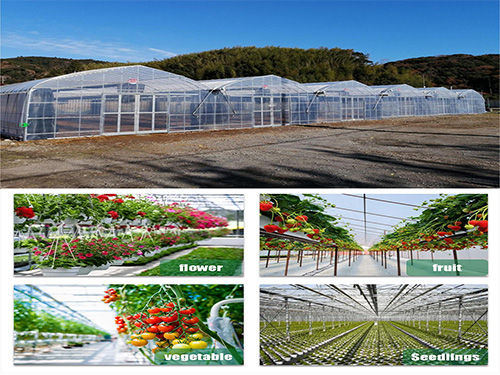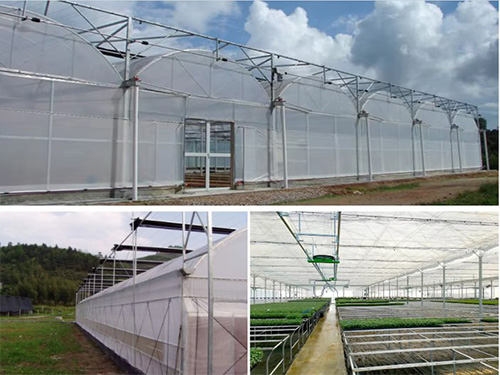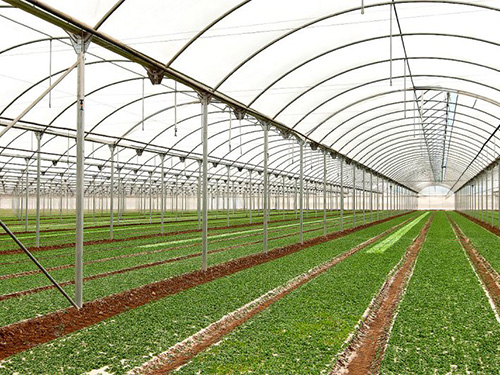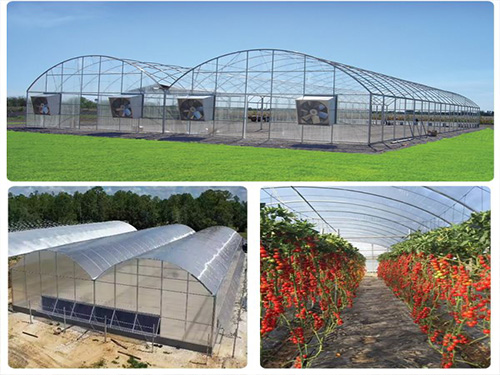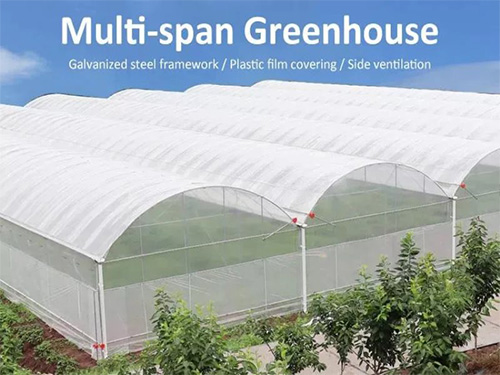NEWS DETAILS
NEWS INFORMATION
High-Tech Greenhouses: Using Smart Devices to Boost Productivity
AUTHOR:jyxd-greenhouse DATE:2025-01-18 15:44:09 HITS:132
In the world of modern agriculture, high-tech greenhouses are transforming how crops are grown, harvested, and managed. By integrating smart devices and cutting-edge technologies, these greenhouses are improving efficiency, maximizing yields, and contributing to sustainable farming practices. This article explores how smart devices are being used in high-tech greenhouses to boost productivity, reduce resource consumption, and optimize plant growth.
What Are High-Tech Greenhouses?
High-tech greenhouses are advanced farming environments equipped with digital technologies, sensors, and automated systems to optimize plant growth. These greenhouses combine traditional growing techniques with innovative technologies such as smart devices, climate control systems, and data analytics to create the ideal conditions for crops. The goal of high-tech greenhouses is to increase productivity, improve crop quality, and reduce the environmental impact of farming.
The integration of smart devices in high-tech greenhouses plays a crucial role in achieving these objectives. These devices monitor, control, and adjust various environmental factors within the greenhouse, ensuring that plants receive the best possible growing conditions.
Key Smart Devices Used in High-Tech Greenhouses
The success of high-tech greenhouses relies heavily on the smart devices used to monitor and control critical environmental factors. These devices allow greenhouse operators to manage the conditions within the greenhouse more efficiently, ensuring optimal growth for a wide variety of crops. Some of the key smart devices used in high-tech greenhouses include:
1. Climate Control Systems
Climate control systems are at the heart of high-tech greenhouses. These systems automatically adjust temperature, humidity, and ventilation to maintain optimal conditions for plant growth. Smart climate control systems can be programmed to respond to changes in environmental conditions, such as outdoor temperature fluctuations or rising humidity levels, ensuring a consistent, controlled environment for plants.
· Temperature Sensors: These devices monitor the internal temperature of the greenhouse and activate heating or cooling systems when necessary.
· Humidity Sensors: Humidity levels are crucial for plant health, and smart humidity sensors help maintain the ideal moisture balance in the air.
· Ventilation Fans: Automated ventilation fans ensure that the greenhouse has proper airflow, which helps prevent heat buildup and maintains the right humidity levels.
These devices work together to create an environment that maximizes plant growth, reduces the risk of disease, and improves energy efficiency.
2. Automated Irrigation Systems
Water management is a critical factor in greenhouse farming. Smart irrigation systems automate the watering process, ensuring that plants receive the precise amount of water they need at the right time. These systems are equipped with soil moisture sensors that measure the water content in the soil and trigger irrigation when necessary.
· Soil Moisture Sensors: These sensors monitor the moisture levels in the soil and activate irrigation systems to prevent over-watering or under-watering.
· Drip Irrigation: Drip irrigation systems deliver water directly to the roots of plants, minimizing water waste and ensuring efficient use of resources.
Automated irrigation systems help reduce water consumption, increase efficiency, and promote healthier plants by ensuring they receive consistent moisture levels.
3. Smart Lighting Systems
Lighting is another key factor in greenhouse productivity, especially in environments where natural sunlight may be limited. Smart lighting systems are designed to optimize the amount of light plants receive, enhancing photosynthesis and promoting growth. These systems use light sensors to detect the amount of natural sunlight available and adjust the intensity of artificial lights accordingly.
· LED Grow Lights: These energy-efficient lights provide the optimal spectrum of light for plant growth and can be adjusted to mimic natural sunlight patterns.
· Light Sensors: These sensors measure the light intensity inside the greenhouse and adjust the artificial lighting to maintain a consistent light level for plants.
Smart lighting systems help increase energy efficiency while ensuring that plants receive the right amount of light, leading to faster growth and higher yields.
4. Environmental Monitoring Systems
Environmental monitoring systems use a combination of sensors to collect real-time data on various greenhouse conditions. These systems monitor factors such as temperature, humidity, CO2 levels, and light intensity, providing greenhouse operators with detailed insights into the growing environment.
· CO2 Sensors: CO2 is a vital component of photosynthesis, and these sensors help maintain the ideal levels of carbon dioxide in the greenhouse.
· Air Quality Sensors: These sensors monitor the air quality within the greenhouse, helping to detect any potential issues that could affect plant health.
By collecting and analyzing data from environmental monitoring systems, greenhouse operators can make data-driven decisions to improve plant growth and productivity.
5. Automated Fertilization Systems
Fertilizer is essential for plant growth, but too much or too little can have detrimental effects on crop yields. Smart fertilization systems automate the process of delivering nutrients to plants, ensuring that they receive the right amount of fertilizer at the right time. These systems often integrate with soil sensors that monitor nutrient levels and adjust the fertilizer delivery based on the plants' needs.
· Nutrient Sensors: These sensors measure the levels of essential nutrients in the soil and trigger the release of fertilizers when required.
· Fertigation Systems: Fertigation systems mix fertilizers with water and deliver them directly to the plants through the irrigation system, ensuring even distribution.
Automated fertilization systems help reduce fertilizer waste, improve nutrient uptake, and optimize plant growth.
Benefits of Using Smart Devices in High-Tech Greenhouses
The integration of smart devices into greenhouse operations offers a wide range of benefits, all of which contribute to increased productivity and more sustainable farming practices. Some of the key advantages include:
1. Increased Efficiency
Smart devices automate many aspects of greenhouse management, reducing the need for manual labor and human intervention. Automation ensures that environmental conditions are always optimal, minimizing human error and increasing overall operational efficiency.
2. Resource Conservation
By monitoring and controlling resource use—such as water, energy, and fertilizers—smart devices help conserve valuable resources. Automated irrigation systems ensure that plants receive just the right amount of water, while climate control systems optimize energy use, leading to lower energy costs.
3. Improved Crop Yields
With the ability to maintain the ideal growing conditions for plants, smart devices help improve crop yields and quality. Automated systems ensure that plants are consistently exposed to optimal temperatures, humidity levels, and light, resulting in healthier, more productive crops.
4. Data-Driven Decision Making
Smart devices collect vast amounts of data that greenhouse operators can use to make informed decisions about their operations. By analyzing data on environmental conditions, water usage, and plant health, operators can identify trends, optimize growing practices, and improve crop management.
5. Sustainability and Environmental Impact
Smart devices help reduce the environmental impact of greenhouse farming by optimizing resource use, minimizing waste, and promoting sustainable farming practices. This makes high-tech greenhouses a more environmentally friendly option compared to traditional farming methods.
Conclusion
The integration of smart devices into high-tech greenhouses is revolutionizing modern agriculture. By using smart sensors, automated systems, and data analytics, greenhouse operators can optimize growing conditions, reduce resource consumption, and increase crop yields. The benefits of these technologies extend beyond productivity, contributing to sustainability and environmental stewardship in farming. As technology continues to evolve, the role of smart devices in greenhouses will only become more important, helping to meet the growing demand for food in a more efficient and sustainable way.
Hebei Juyou Xinda Greenhouse Facilities Co.,Ltd.
Copyright © 2024-2025 https://www.jyxd-greenhouse.com. All Rights Reserved Hebei Juyou Xinda Greenhouse Facilities Co.,Ltd.Copyright






 Current Location:
Current Location:


